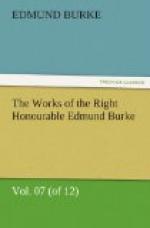The Druid temple is represented to have been nothing more than a consecrated wood. The ancients speak of no other. But monuments remain which show that the Druids were not in this respect wholly confined to groves. They had also a species of building which in all probability was destined to religious use. This sort of structure was, indeed, without walls or roof. It was a colonnade, generally circular, of huge, rude stones, sometimes single, sometimes double, sometimes with, often without, an architrave. These open temples were not in all respects peculiar to the Northern nations. Those of the Greeks, which were dedicated to the celestial gods, ought in strictness to have had no roof, and were thence called hypaethra.[14]
Many of these monuments remain in the British islands, curious for their antiquity, or astonishing for the greatness of the work: enormous masses of rock, so poised as to be set in motion with the slightest touch, yet not to be pushed from their place by a very great power; vast altars, peculiar and mystical in their structure, thrones, basins, heaps or cairns; and a variety of other works, displaying a wild industry, and a strange mixture of ingenuity and rudeness. But they are all worthy of attention,—not only as such monuments often clear up the darkness and supply the defects of history, but as they lay open a noble field of speculation for those who study the changes which have happened in the manners, opinions, and sciences of men, and who think them as worthy of regard as the fortune of wars and the revolutions of kingdoms.
The short account which I have here given does not contain the whole of what is handed down to us by ancient writers, or discovered by modern research, concerning this remarkable order. But I have selected those which appear to me the most striking features, and such as throw the strongest light on the genius and true character of the Druidical institution. In some respects it was undoubtedly very singular; it stood out more from the body of the people than the priesthood of other nations; and their knowledge and policy appeared the more striking by being contrasted with the great simplicity and rudeness of the people over whom they presided. But, notwithstanding some peculiar appearances and practices, it is impossible not to perceive a great conformity between this and the ancient orders which have been established for the purposes of religion in almost all countries. For, to say nothing of the resemblance which many have traced between this and the Jewish priesthood, the Persian Magi, and the Indian Brahmans, it did not so greatly differ from the Roman priesthood, either in the original objects or in the general mode of worship, or in the constitution of their hierarchy. In the original institution neither of these nations had the use of images; the rules of the Salian as well as Druid discipline were delivered in verse; both orders were under an elective head; and both were for a long time the lawyers of their country. So that, when the order of Druids was suppressed by the Emperors, it was rather from a dread of an influence incompatible with the Roman government than from any dislike of their religious opinions.




